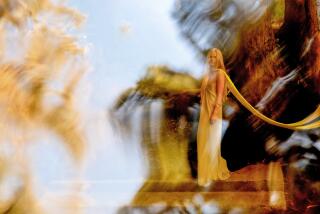Messenger from a burning house
- Share via
IN THE Age of the Image, when some of us sit like the prisoners in Plato’s cave, transfixed by the projections cast on the wall before us (and ignoring the reality at our backs), those who wish to grab our attention -- and hold it -- have to turn themselves into fairy tales, or “human interest stories” at the very least, that fit the simple contours of a child’s parable: the boy from Hope, the peanut farmer from Plains (the names themselves conveying an all-American sound of allegory) or the brilliant performer locked inside his Neverland. If the beginnings of their stories have the feel of fairy tale, so too -- the logic goes -- might the endings they promise to provide.
The 14th Dalai Lama is in the curious position of attempting just the opposite: Born in a cowshed in a remote Tibetan village and chosen by a search-party of monks to be head of his people at the age of 2, he travels the world ceaselessly to tell us, in effect, that he’s not a character from fairy tale at all and that the suffering of his people is real, and desperate.
Already Tibetans are a minority in their traditional homeland. And they can still be imprisoned for 12 years by their Chinese occupiers if they are found with a picture of their temporal and spiritual leader.
The last time I was in Lhasa, the Tibetan capital, high-rise hotels and shopping malls and karaoke parlors blocked the view of the Potala Palace, long the center of classical Tibet. When a railway linking Golmud, China, to Lhasa is completed (in advance of the 2008 Olympics in Beijing), it is believed that Tibet, as an individual culture and self-contained land, could be gone forever.
The situation is so dire that parents from Tibet send their children on hazardous, 20-day trips across the highest mountains on Earth in order to get to freedom and to learn about their culture and philosophy in Dharamsala, the ramshackle hill station in India where the Dalai Lama has made his home in exile for 46 years. Mother will never see child again, but at least the child will know something of his motherland.
When the Dalai Lama travels out of Dharamsala and into the world, he comes to alert us to the fact that 6 million Tibetans could lose their homeland in a year or two. He arrives more or less as a messenger from a burning house.
We, however, need him to be a source of spiritual hope, and we long for him, implicitly, to be a miracle worker out of a fairy tale. “You come from the Land of Snows,” we say, in effect, “full of monks who can fly and snow leopards and children who are named king at the age of 2. Please give us some of your ancient wisdom.” He says, in effect, “I’m a fallible man in the 21st century, and I need your help as you need mine.”
In Dharamsala this spring, I spoke with a young Tibetan (who works for his homeland in Colorado). “Please tell people ... that the Dalai Lama and Tibet have a political meaning as well as a spiritual one,” he said. (The first principle Tibetan Buddhists honor, he might have added -- one equivalent to God, you could say -- is reality).
When the Dalai Lama offered philosophical teachings weeks before, at least 8,000 pilgrims packed the courtyard daily, a quarter of them foreigners. The day after the teachings ended, he gave a talk on Tibet’s political situation, and the courtyard was noticeably less crowded, most of the people in attendance Tibetan.
How to try to preserve Tibet after half a century of occupation remains a tangled question: More and more Tibetans in exile, especially the young, believe the Dalai Lama is too conciliatory, too ready to forgive, and some urge attacks on Chinese power stations, roads and even officials. When the Dalai Lama, who just turned 70, is no longer around, it’s possible that some Tibetans will turn, in desperation, to terrorism. His gamble -- and hope -- is that by taking the high road, and speaking for universal principles of tolerance and trust, he will gain some (mostly invisible) ground in the long run.
Those of us outside the Tibetan community face a very different, but no less urgent, task: As the Dalai Lama travels through the U.S., those who long to see him, to touch him, those who are eager to bask in his infectious optimism and warmth, must also try to help him in the place where he needs it most: urging China to change its policies before there is no Tibet to save.
Otherwise we just seize the parts of his message that inspire us and ignore the parts that challenge us. In doing so, we become dangerously close to being children gathering around a spiritual godfather, hungry for his wisdom and hardly caring that his home, across the way, is going up in flames.


